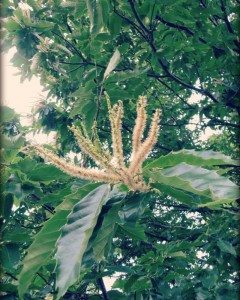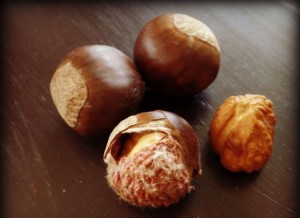Prior to the blight in the early 20th century, American chestnut trees covered the eastern United States. Homes, barns and fences were made from hard, straight-grained chestnut lumber. Chestnuts were enjoyed by humans and used as a mineral rich feed supplement for livestock.
In the early 1900s a fungal blight wiped out the American chestnut tree population. The mature chestnut trees you see today are likely Chinese-American crosses. Crossing Chinese and American chestnut trees is an effort to breed the American chestnut back with disease resistance.
There are currently several blight resistant chestnut varieties available for nut lovers to purchase and plant at home.
Why plant chestnut trees?
 Sweet-tasting nutritious nuts can be eaten fresh, roasted, raw or salted. Chestnuts can be ground into flour and are even used to brew craft beer. Chestnuts can be preserved in dry storage or frozen.
Sweet-tasting nutritious nuts can be eaten fresh, roasted, raw or salted. Chestnuts can be ground into flour and are even used to brew craft beer. Chestnuts can be preserved in dry storage or frozen.
Chestnut trees are well-suited to grow in the eastern U.S. Trees need 6-8 hours of sun. Roots thrive in fertile soil. Cross-pollination by a different variety is required; purchase two or more trees for optimal pollination.
Space trees with plenty of room to grow. Chestnut trees grow to an average height of 25-30 feet tall. Experts recommend spacing 35-40 feet between trees.
How to plant chestnut trees
- Water trees in container very well before planting.
- Dig a hole wide and deep enough to accommodate the root system.
- Place backfill soil in a wheel barrow or like container. Mix in compost, fertilizer or soil amendments to create a rich, loamy backfill.
- Loosen the tree from the container. Gently set in hole, spreading roots.
- Plant the tree at the same depth it was growing in the container.
- Backfill around the tree with improved soil.
- Tramp down soil to minimize air pockets.
- Water well.
- Add trunk protection and a layer of mulch to protect roots.
Caring for new chestnut trees
Prune young trees the first year to produce shapely branches and a strong central leader. When the central leader grows to be 8 feet tall, prune it back to encourage tree to widen. Make sure roots receive plenty of water. Fertilize and mulch as needed.
Harvest, curing and storage
 Chestnut trees will produce a sizable crop after 3-5 years. My trees drop burs between late September and early October. I wear thick gloves to protect my hands from prickly burs. Burs typically contain one well-developed nut plus one or two shriveled, undeveloped nuts. Pry open burs, remove developed nuts and discard the bur casing with undeveloped nuts.
Chestnut trees will produce a sizable crop after 3-5 years. My trees drop burs between late September and early October. I wear thick gloves to protect my hands from prickly burs. Burs typically contain one well-developed nut plus one or two shriveled, undeveloped nuts. Pry open burs, remove developed nuts and discard the bur casing with undeveloped nuts.
Spread nuts in a single layer to dry cure for one week. Store nuts in-shell a cool, dry and pest-free place with good ventilation. Alternatively you can peel and freeze raw chestnuts.
More about chestnuts
- American chestnut on the comeback trail Sept. 9, 2014
STAY INFORMED. SIGN UP!
Up-to-date agriculture news in your inbox!













We have two lovely trees. Every year it a race to see who gets to eat the Chestnuts… us or the deer! I really don’t mind too much if the deer eat them, though.